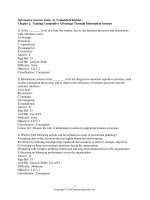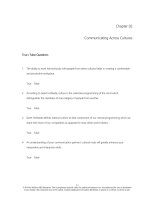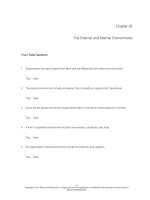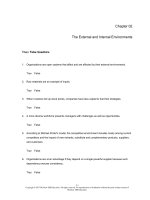Lesikars business communication connecting in a digital world 13th edition rentz and lentz solution manual
Bạn đang xem bản rút gọn của tài liệu. Xem và tải ngay bản đầy đủ của tài liệu tại đây (577.99 KB, 13 trang )
Lesikars Business Communication Connecting in a
Digital World 13th edition Rentz and Lentz Solution
Manual
Link full download solution manual: />
Chapter 2: Communicating Across Cultures
Teaching Suggestions
Slides 2-1, 2-2
The subject matter of this chapter lends itself best to lecture and discussion. If your experience
permits, you can enrich the lecture with additional material. If you have nonnative students in the
class, they can be a wonderful resource. Encourage them to talk frankly about their experiences in
different countries, their language problems, and their views about different cultures’ communication
practices. Students who have traveled abroad can also add to the discussion. If your area has a
company with an executive responsible for cultural diversity in the workplace, inviting him or her to
speak is another idea.
The questions at the end of the chapter are designed to generate discussion and to stress the text
highlights. And the application exercises help students practice communicating with nonnatives.
Text Summary, Lecture Outline
Importance of Cross-Cultural Communication
Slide 2-3
Technological advances have made doing business more global. Large and small companies now
have both employees and customers in other countries.
By understanding customers from other cultures better, we will be better able to design products and
services that fit their needs.
Successful communication across cultures improves productivity and creates a comfortable workplace.
Finally, communicating with those from other cultures enriches not only the business but also
one’s personal life.
This slide can be used for an interactive discussion. Ask students to give examples they know of that
support each of the points given here.
You may want to ask students to give examples of times they were embarrassed in a cross-cultural
situation or tell an anecdote of your own to break the ice. Did they misunderstand someone’s accent or
what someone was saying? Did they accidentally offend someone from another culture?
On the positive side, ask students if they’ve ever had a close personal or professional relationship with
a person from another culture. What communication challenges arose? What did they gain from the
relationship?
Another entertaining possibility for discussion is sharing some famous, humorous international gaffes
that politicians have made when communicating with leaders of other countries. The class can bond
over these, since some are well-known, and it adds a little laughter and familiarity to new material.
2-1
© 2014 by McGraw-Hill Education. This is proprietary material solely for authorized instructor use. Not authorized for sale or distribution
in any manner. This document may not be copied, scanned, duplicated, forwarded, distributed, or posted on a website, in whole or part.
Chapter 2 – Communicating Across Cultures
Slide 2-4
You can use this slide to open up a rich discussion about culture. Ask students if they agree with
Dutch sociologist Geert Hofstede’s definition of culture. Better yet, ask them to write down their own
definitions of culture before sharing this slide and then compare and contrast.
Slide 2-5
You can use this slide to help students think about the big picture, as the text advises them to do. Students
are often too quick to zero in on particular cultures’ habits and traits, which students are likely to view as
peculiar or to misunderstand, unless seen in the larger context of the culture’s history, location, and so
forth. Help students appreciate the wide variety of cultures out there—and also the similarities across
cultures that enable businesspeople from these various cultures to work together.
Slide 2-6
The three major factors that affect culture are topography, history, and religion. Chapter 2 contains
an in-depth discussion on each of these.
For students not able to see these on a macro, international level across cultures, it may be helpful to
look at them on a micro, personal level.
Have them consider, for a moment, their own hometowns and states. How was the culture there
influenced by topography, such as the tourist-trap lake community or isolated farm community?
What was the town’s or city’s history and how did it influence collective thinking and beliefs?
What were the different religions and how did they impact the overall culture? For instance, how did
religious beliefs affect collective thinking, politics, relationships, attitudes towards marriage,
entertainment, and the arts?
This discussion may help U.S. students understand that even within their own classroom every person
has a slightly different cultural perspective. This can open their minds to broader cross-cultural
thinking.
Slide 2-7
Using examples from the book, your own experience, and your students’ experiences, discuss the
different meanings of various body positions and movements across cultures:
Gestures frequently have very different meanings from one culture to another.
Eyes are used differently in some cultures. What seems like a stare to one may seem appropriate to
another.
Touching and handshaking practices and preferences vary by culture too.
2-2
© 2014 by McGraw-Hill Education. This is proprietary material solely for authorized instructor use. Not authorized for sale or distribution
in any manner. This document may not be copied, scanned, duplicated, forwarded, distributed, or posted on a website, in whole or part.
Chapter 2 – Communicating Across Cultures
Even facial expressions such as smiles and raising of the eyebrows communicate differently across
cultures.
See if students can think of examples of other physical signs whose meanings might
be miscommunicated across cultures.
Slide 2-8
The text gives more examples of how meanings of these physical parts/acts can vary across culture.
A fun class activity at the start of the Chapter 2 lecture is to show this slide after introducing the
chapter, and have students ―meet and greet‖ using one of the handshakes. (You can call this the ―crosscultural cocktail party‖ without cocktails.) Particularly since it’s the beginning of the course, it’s a
great opportunity for students to get to know each other and bring the material to life. The student on
the receiving end guesses if the handshake is French, American, British, etc. and returns one of his or
her own.
Or you can use the activity to gracefully end the lecture and transition into group work.
Slide 2-9
Here, too, use examples to heighten students’ awareness that many factors of human relationships that
they assume are universal (and therefore ―normal‖) are not.
Time is one factor businesspeople need to understand. Some cultures, such as the Germans, believe in
precise punctuality. Other cultures have a much more relaxed attitude toward time, not valuing
punctuality highly.
Space use differs across cultures. Some cultures view space as belonging to all, and others believe in
personal space. One from a culture where space belongs to all might not recognize that he or she is
violating the personal or intimate space of someone from another culture.
Odors also carry different messages in different cultures. While one culture may value body odors,
another culture may value covering them up. As the text states, ―Americans work hard to neutralize
body odors or cover them up and view those with body odors as dirty and unsanitary. On the other
hand, in some Asian cultures people view body odors not as something to be hidden but as something
that friends should experience.‖
Frankness variations can also impede communication. The directness that one person may view as
appropriate may seem too abrupt and unfriendly to someone else.
Social hierarchy can influence communication practices. In some cultures, strict social classes exist.
A person from one culture may quiz a person from another culture to determine that person's class
status. Questions concerning occupation, income and title may even be asked. This can be offensive to
some cultures. Also, some Americans immediately call people by their first names, a practice
offensive to the Germans and English.
2-3
© 2014 by McGraw-Hill Education. This is proprietary material solely for authorized instructor use. Not authorized for sale or distribution
in any manner. This document may not be copied, scanned, duplicated, forwarded, distributed, or posted on a website, in whole or part.
Chapter 2 – Communicating Across Cultures
Workplace Values. Works ethics and values vary across cultures. Many Americans, for instance, have a
Protestant work ethic that puts work before pleasure. In Spain, business is more relaxed, more emphasis
is placed on human relationships, and there is a general view that planning can be futile.
Expression of emotion can be causes of miscommunication. For example, the display of public
affection may be acceptable behavior in one culture and totally unacceptable in another.
You may want to ask students to think of times when they felt surprised by a cross-cultural interaction
because of one of these factors or share one of your own anecdotes.
These may be interesting points of discussion, assuming that cultural sensitivity and the diversity
of the classroom is taken into account.
Slide 2-10
Before moving on to the second main topic of the chapter, you might pause to take a closer look at the
three Communication Matters boxes that present different frameworks for understanding cultures.
Edward Hall’s framework (page 33) has been challenged but seems to have value as a general
interpretive tool. To help students understand the ―high-context/low-context‖ idea, you might have
them recall and share communication situations they’ve experienced in which much of the
background could be assumed (as when talking with a close friend) and those in which very little
could (as when talking with someone of a different age or with very different frames of reference).
Geert Hofstede’s work on cultural difference (see page 34) is widely known and applied. As you
explain each dimension, invite students to validate or challenge these with their own experiences.
When you’ve covered the whole list, ask if anyone can think of additional dimensions that might be
added.
Richard Lewis’s framework (page 35) might actually be one possible answer to this question,
since his model arguably addresses a dimension that Hofstede leaves out. Ask students what they
think about the usefulness of Lewis’s concepts.
The overall point is that no one has a comprehensive, foolproof device for analyzing cultures—these
are just interpretive aids. As the executive quoted in the box on Hofstede says, such aids are helpful
but crude; one must ultimately assess each situation and each communication partner on one’s own.
Slide 2-11
The ―Effects on Business Communication‖ segment of this chapter (page 36) discusses these issues indepth. Students should understand that there is no formula for communication when conversing across
cultures.
The textbook was written for U.S. readers, so guidelines for writing messages may not apply to all
cultures. For instance, the British prefer a direct approach to negative messages whereas the U.S.
prefers to soften news before delivering. Asian cultures may view our communication style as
―too direct.‖
Even social networking preferences vary from culture to culture.
2-4
© 2014 by McGraw-Hill Education. This is proprietary material solely for authorized instructor use. Not authorized for sale or distribution
in any manner. This document may not be copied, scanned, duplicated, forwarded, distributed, or posted on a website, in whole or part.
Chapter 2 – Communicating Across Cultures
Problems of Language
Slides 2-12, 2-13, 2-14, 2-15
This slide identifies some of the problems the language imposes on communication across cultures. It
can be used to introduce the specific examples in slides 2-13 to 2-23.
Lack of language equivalency: A lack of language equivalency is a contributing factor to
miscommunication. Across the planet, people use more than 3,000 languages. Because few of us can
learn more than one or two other languages well, problems of miscommunication are bound to occur
in international communication.
Different cultures have different concepts, experiences, and views. For example, our word
supermarket may have no equivalent translation because there is no need for it if such stores do not
exist. Similarly, Italians have over 500 words for types of pasta since it is important to their
experience.
Sometimes words have no equivalent because the language has no equivalent part of speech. This is
often true of gerunds, adjectives, and adverbs.
Multiple meanings of words: Adding to these equivalency problems is the problem of multiple
word meanings. Like English, other languages have more than one meaning for many words. The
Oxford English Dictionary uses over 15,000 words to define what. Unless one knows a language
well, it is difficult to know which of the meanings is intended.
Two-word verbs: One of the most difficult problems for nonnative speakers of English is two-word
verbs. This is defined as wording consisting of 1) a verb and 2) a second element that, combined with
a verb, produces a meaning that the verb alone doesn't have. Examples include break up, break away,
and break down.
Slang/colloquialisms and culturally derived words/phrases: Within a culture, certain manners of
expression may also be used in a way that their dictionary translations and grammatical structures do
not explain.
See if students can link the examples on slide 2-13 to the country/culture of the language from which
the examples come. Help them see that language is an index to the values and practices of a culture.
Why might we not have any equivalency in the U.S.?
For slide 2-14, ask students to consider why other cultures may not have these English words. For
slide 2-15, ask students to consider how certain English expressions might be interpreted by other
cultures.
2-5
© 2014 by McGraw-Hill Education. This is proprietary material solely for authorized instructor use. Not authorized for sale or distribution
in any manner. This document may not be copied, scanned, duplicated, forwarded, distributed, or posted on a website, in whole or part.
Chapter 2 – Communicating Across Cultures
Slides 2-16, 2-17
Multiple meanings of words contribute to the language problem. As the Communication Matters box
on page 37 points out, some U.S. advertisers have learned this the hard way when their formerly
effective product slogans were translated into other languages.
Use the simple examples on this slide to sensitize students to the many meanings that some words can
have.
One technique used to overcome these problems in important messages is called ―back translating.‖
It involves using two translators: each having first language and second language skills in opposite
relevant languages.
Slide 2-18
Two-word verbs often create difficulties for nonnatives. Two-word verbs combine a verb and a
second word to create a meaning that the verb alone does not convey. Taking care to substitute a more
easily understood word or phrase—as this slide illustrates—improves the communication.
Slides 2-19, 2-20, 2-21, 2-22
Culturally derived words also impede communication. Avoiding slang expressions, American
idioms, and colloquialisms will help immensely. Nonnatives have often learned English from
dictionary meanings, and they have trouble discriminating between the different shades of
meanings that we give words.
See if students can think of additional problematic examples beyond those on these slides and
then replace them with more cross-culturally friendly substitutes.
For slide 2-22, ask students to guess the meanings of these idioms from other cultures to develop
some empathy for nonnative speakers in the U.S.
Slide 2-23
Sometimes companies make blunders in international business through their products, practices, and
words.
You might ask students to share their own examples of funny blunders experienced by marketers
attempting to reach across cultural boundaries.
Also, consider asking students why they think this occurs. Did the marketing departments and
advertising agencies just not do their research? What do they think happened? Researching the
reasons for some of these famous incidents before the lecture helps complete the discussion.
2-6
© 2014 by McGraw-Hill Education. This is proprietary material solely for authorized instructor use. Not authorized for sale or distribution
in any manner. This document may not be copied, scanned, duplicated, forwarded, distributed, or posted on a website, in whole or part.
Chapter 2 – Communicating Across Cultures
Advice for Communicating Across Cultures
Slide 2-24
Do your research. The Internet makes it so easy to find out about other cultures that there is no excuse for not
doing so if one anticipates a cross-cultural communication event. But more in-depth research may be necessary.
Discuss other good sources of information.
Know yourself and your company. It is tempting to prepare for a cross-cultural experience only by studying
the culture of the ―other‖ country. But we all know that company cultures vary widely even in one country—and
people in other countries may have certain stereotypical views of us. You might discuss ways to analyze one’s
company culture and one’s own values and communication styles in order to be a more aware, agile communicator.
Be aware—and wary—of stereotypes. The word stereotypes has acquired a negative connotation over the
years, especially as we have become more appreciative of diversity of all kinds. But stereotypes can be handy
interpretive devices. After all, most of them have arisen because of perceived similarities or patterns, so they often
have some predictive value. But the sensitive cross-cultural communicator is quick to alter the stereotype in the face
of contrary evidence. Not to do so would be lazy and even unethical.
Adapt your English to your audience. Many nonnative English speakers have an amazing grasp of the
English language. Even so, certain features of our discourse can give them undue trouble. To maximize your
chances of being understood, follow the advice listed here and on earlier slides.
Be open to change. Businesspeople are goal oriented, and that sometimes makes them plow ahead when they
should be listening and reflecting. Cross-cultural communication is an opportunity to grow as a person, a
businessperson, and a world citizen. An open, flexible attitude will help you reap these benefits.
That being said, intercultural businesspeople do sometimes encounter indefensible business practices. Have an
honest discussion with your class about examples of these and explore possible solutions.
Slide 2-25
This slide presents an excellent opportunity for students to follow the advice on cross-cultural communication
and ―know themselves.‖ Consider forming a quick self-test based on the three theoretical frames of
communication in your text, and discussed on slide 2-10, and have students discover their own communication
styles.
Resources
Slides 2-26, 2-27, 2-28, 2-29, 2-30
Many resources are available for learning about other cultures and for help with other languages. Figure 2-3 on
page 42 lists some of the best of these.
These last slides show five helpful computer-based tools. Travlang has a wealth of assistance, from a translation
program to a currency converter to world facts (you can zoom into the links on the left to explore these).
Word comes with its own built-in translation program (the slide shows a brief email in English translated into
French).
2-7
© 2014 by McGraw-Hill Education. This is proprietary material solely for authorized instructor use. Not authorized for sale or distribution
in any manner. This document may not be copied, scanned, duplicated, forwarded, distributed, or posted on a website, in whole or part.
Chapter 2 – Communicating Across Cultures
The next slide shows one of the best Internet resources for learning about other cultures: The U.S.
State Department’s Country Background Notes.
Slide 2-29, The Delta Intercultural Academy, is a knowledge community for those interested in intercultural
business and management communication. You can find articles, conference information, and research.
Slide 2-30, The World Factbook supported by the Central Intelligence Agency, is a good place to verify facts
about the countries you’re researching.
Answers to the Critical Thinking Questions
1.
Put yourself in the shoes of the trainer described in this chapter’s Introductory Situation. What
might have been a better way to handle the situation? Explain why.
Answers can vary, but one possible solution would be to have followed up with Prasan in private
about what you needed from him rather than put him on the spot in front of others. Also, instead of
saying when you needed the documents, you could have asked Prasan what a workable timetable for
him would be, given his other commitments.
2.
What are the prevailing attitudes in our culture toward the following and how can these
attitudes affect your communication with nonnatives? Discuss.
The answers are likely to vary, depending somewhat on the number of nonnative students in your class.
But don’t expect your native students to agree on the prevailing attitudes in their culture. The
discussion should bring out a variety of ways in which these attitudes can affect our communication
with others. All are a result of our tendencies to act as if our attitudes are right and all others are wrong.
Probably the discussion will bring out the following general points:
a.
Negotiating methods. Our culture generally favors truth in product representation, a service
attitude, and a minimum of price haggling. Some cultures have sharply different attitudes on these
points, especially on price haggling. Of course, some students are likely to question the extent to which
these attitudes exist. Probably the class will agree more on what should be than on what actually is. The
class should agree that our methods are more aggressive than the methods of some cultures and less
aggressive than those of others. Thus, using a ―wrong‖ method for a culture could be disastrous.
b.
c.
d.
e.
Truth in advertising. Probably all will agree that truth is desired and that advertisers often stray
from truth. In fact, there appears to be a general tolerance for some degree of puffery. Even so,
there are limits to the acceptance of false claims. These limits vary from culture to culture.
Company–worker loyalty. In the U.S., loyalty to one’s company is far less important than in
some other cultures. We are likely to change jobs often during a career, always looking out for our
best interests. And our companies hire and fire based on their best interests. In contrast,
employment in Japan is more a life-long relationship involving a mutual loyalty between workers
and the company.
Women’s appropriate roles in society. In the U.S., emphasis on equality between the sexes has
become widespread. Although most would agree that complete equality does not exist,
considerable progress has been made. This progress is especially evident when one views the role
of women in some other cultures (in some countries or amidst some sects in the Middle East, for
example). One of our female business executives could have difficulty conducting business with
executives (probably male) from such cultures.
The Protestant work ethic. An employer with the Protestant work ethic might have different
expectations than an employee from a culture without it. These different expectations could lead to
assumptions that create conflict.
2-8
© 2014 by McGraw-Hill Education. This is proprietary material solely for authorized instructor use. Not authorized for sale or distribution
in any manner. This document may not be copied, scanned, duplicated, forwarded, distributed, or posted on a website, in whole or part.
Chapter 2 – Communicating Across Cultures
3.
Some of our message-writing techniques are said to be unacceptable to people from such
cultures as those of Japan and England. Which techniques in particular do you think
would be most inappropriate in these cultures? Why?
The question will bring out a variety of answers. Probably our somewhat aggressive, lively
sales writing and our emphasis on using words to create a goodwill effect (your viewpoint,
positive wording) are the most accurate responses.
The reasons for these objections differ by culture and are many. The overriding one is that our
techniques conflict with the ways these people have behaved and thought in the past. The
English, for example, have a history of formal, conservative business relationships, and the
Japanese have developed their own cultural practices for dealing with each other. Both
cultures value manners more than we typically do. Thus, our directness and our informal,
personal language might be considered crude.
4.
Think of English words (other than this chapter's examples) that probably do not have precise
equivalents in some other cultures. How would you attempt to explain each of these words to a
person from such a culture?
Many words are suitable responses to this question (bull session, jamboree, shopping mall, cheerleader,
freeway, speed trap, parking meter). The important part of the answer is the explanation. The words
and concepts used must convey clear meanings to one who does not know our language and our ways
well. You will need to weigh each student’s explanation carefully from the position of a nonnative with
a limited knowledge of our language and culture.
5.
Select a word with at least five meanings. List those meanings and consider how you would
communicate each of them to a nonnative.
This question also can produce many answers (park, bridge, track, fly, base, flag, rock, heart, case, tie,
box, swing). You will have to evaluate subjectively the explanations of how the words would be
defined to a nonnative. The explanations should take into account the particular culture involved.
Listen to detect how clear, basic English is used and how the explanations relate to the knowledge and
experience of the nonnative.
6.
Is a conversational style appropriate in writing to nonnative readers? Discuss.
Much depends on how one defines conversational style. Certainly if it means using the slang and
colloquial expressions of everyday conversation, the answer is no. If it means the clear, simple, and
personable language we should use in talking with nonnatives, the answer is yes.
7.
Select a country or region and analyze the likely impact of its topography, history, and religious
background on its culture.
Suitable responses may analyze such things as the impact geography and topography have on habits and
values; the effect that certain historical events or systems of government have had on national memory;
and what role religion plays in culture, such as how religious values have shaped cultural attitudes and
belief systems. There is obviously no ―right‖ answer, and each answer will be judged on its own merits
and depth of analysis.
2-9
© 2014 by McGraw-Hill Education. This is proprietary material solely for authorized instructor use. Not authorized for sale or distribution
in any manner. This document may not be copied, scanned, duplicated, forwarded, distributed, or posted on a website, in whole or part.
Chapter 2 – Communicating Across Cultures
8.
Study a country’s culture and then infer its people’s likely attitudes toward American values and
behaviors.
By comparing and contrasting another country’s values with American values, inferences can be
made about attitude. Historical relations between countries and issues with that particular nationality
assimilating into American culture may also be considered. Again, each answer will be judged on its
own merits and depth of analysis.
9.
If you were trying to persuade your boss to implement some kind of cross-cultural training in
the company, what kind of evidence might help you make a convincing case?
Responses should show evidence of how the training will impact the bottom line of the business.
Students may focus on benefits such as increasing diversity, improving global marketing and
sales, providing a competitive edge, and overall international business impact.
10. On a recent trip to India, Mr. Yang, a prominent Chinese executive, dined with his client
Himanshu Jain. Mr. Yang commented that the food was spicy, which Mr. Jain interpreted as an
opportunity to discuss Indian cuisine. After lengthy explanations, Mr. Yang commented again
that the food was spicy.
What happened here? What barrier was getting in the way of clear communication? (Adapted from
Danielle Medina Walker, Thomas Walker, and Joerg Schmitz, Doing Business Internationally: The
Guide to Cross-Cultural Success [New York: McGraw-Hill, 2003] 237, print.)
Mr. Yang’s comment was likely misunderstood due in part to his high-context culture. Mr. Jain understood
―spicy‖ to be a comment on the taste of the food. But after Mr. Jain’s explanation, when Mr. Yang repeated
that the food was spicy, an astute receiver might have understood that the food was
―hot‖ and offered Mr. Yang a cool drink.
Suggested Solutions for the Skills Building Exercises
1.
From newspapers and magazines, find and bring to class 10 sentences containing words and
expressions that a nonnative English speaker would not be likely to understand. Rewrite the
sentences for this reader.
Translations should include short, familiar words that don’t have multiple meanings and reflect
the chapter guidelines on adapting language to culture.
2.
Interview a nonnative speaker of English about communication differences between cultures
he or she has experienced. Report your findings to the class in a 10-minute presentation.
A variety of points may be brought out in these presentations. It’s likely that jargon and slang terms
will come up, as well as differences in food preferences and other customs. You may even hear
contradictory points made by nonnatives from the same country, emphasizing that generalizations
help in some respects but do not take into account individual differences.
2-10
© 2014 by McGraw-Hill Education. This is proprietary material solely for authorized instructor use. Not authorized for sale or distribution
in any manner. This document may not be copied, scanned, duplicated, forwarded, distributed, or posted on a website, in whole or part.
Chapter 2 – Communicating Across Cultures
3.
Research a non-English-speaking country on the Internet or in your library. Look for ways in
which the culture of this country might influence the way its citizens do business. Report your
work to the class in a short presentation.
One likely finding is that high-context and low-context cultures differ in their use of background
information and their use of directness. Another is that some non-English cultures may be more oral
than ours, with a handshake serving as a binding contract. And some cultures require more ceremonial
elements in their business dealings than we do. Judge each report on its own merits.
4.
Research differences in business etiquette between your country and another one. Report your
findings to the class.
A number of resources in Figure 2-3 (page 42) can help students here, especially the books. Judge each
report on its own merits.
5. Rewrite the following sentences to accommodate a nonnative English speaker.
a. Last year our laboratory made a major breakthrough in design that really made our
sales skyrocket.
Last year our laboratory made a major discovery that greatly increased sales.
b. You will need to pin down Mr. Wang to get him to tighten up expenses.
You will need to talk with Mr. Wang to convince him to decrease his expenses.
c. Recent losses have us on the ropes now, but we expect to get out of the hole by the
end of the year.
Recent losses have decreased our financial strength, but we expect to be profitable by the end of the
year.
d. We will kick off the advertising campaign in February, and in April we will bring
out the new products.
We will begin the advertising campaign in February, and in April we will begin distribution of our
new products.
e. Maryellen gave us a ballpark figure on the project, but I think she is ready to back
down from her estimate.
Maryellen gave us a general estimate of the cost of the project, but I think she is willing to
change it.
f.
We will pull the plug on any of our products that are flatlining.
We will stop making any of our products that aren't selling well.
g. Mr. Maghrabi managed to straighten up and become our star salesperson.
Mr. Maghrabi solved the problems in his performance and became one of our best salespeople.
h. Now that we have cut back on our telemarketing, we will have to build up our
radio advertising.
Now that we have reduced our telemarketing expenditures, we will have to expand our
radio advertising.
2-11
© 2014 by McGraw-Hill Education. This is proprietary material solely for authorized instructor use. Not authorized for sale or distribution
in any manner. This document may not be copied, scanned, duplicated, forwarded, distributed, or posted on a website, in whole or part.
Chapter 2 – Communicating Across Cultures
i.
If you want to improve sales, you should stay with your prospects until you win
them over.
If you want to improve sales, you should talk with your prospects until you convince them to buy.
j.
We should be able to haul in a savings of 8 or 10 grand.
We should be able to save 8 to 10 thousand dollars.
2-12
© 2014 by McGraw-Hill Education. This is proprietary material solely for authorized instructor use. Not authorized for sale or distribution
in any manner. This document may not be copied, scanned, duplicated, forwarded, distributed, or posted on a website, in whole or part.









